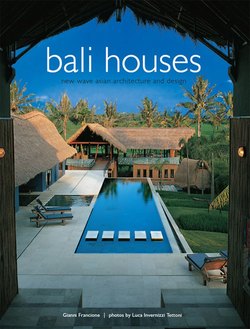Читать книгу Bali Houses - Gianni Francione - Страница 9
На сайте Литреса книга снята с продажи.
ОглавлениеA modern version of the balé in the garden.
variations on a theme
Situated in the middle of rice paddies in the Kerobokan district, this project comprises three villas. Abiding by the philosophy of organic architecture, where designs are developed out of their natural surroundings, the houses showcase the spare yet dynamic spaciousness of modernist architecture. Commissioned by Mrs Sin Sin, an entrepreneur from Hong Kong, the project involved the challenge of personalizing each of the three villas while maintaining the main theme of strong and bold structural lines and planes, which is found especially in the roofs. The GM architects achieved this goal through the diversification of geometric forms, simple planes, and articulated structures that combine free-standing walls, solid, detached volumes and different levels in the flooring.
Smooth transitions between the indoors and outdoors characterize this dining area. (See page 192 for credit details.)
The signature of the architects-the fluidity of transition between different environments-is underscored by the use of various natural building materials and by the juxtaposition of vertical and horizontal planes. In the former, wooden shingles from Borneo are used for the roofs, and local teak and bengkerai are employed for the structures and interiors, while a combination of soft and hard stones is used in the walls and flooring. In the latter, an interesting composition of solids and voids is created such that a sense of unrestricted movement is achieved between the dynamic living spaces. Enhancing the feel of the continuity between inside and out is the seemingly random effect produced in the meticulously planned landscaping: paths and lawns merge, emphasizing the partnership between man and nature.
Palimanan stone paths lead to the entrance of the living quarters, on the right, and private quarters, on the left. The wooden shingles of the bold geometric roofs are an all-embracing shelter and ease the indoor-outdoor transition. In the foreground, an ethnic stone statue welcomes guests.
The swimming pools are a main feature of this compound. In the villa on left, the water comes right to the edge of the dining area, which is also highlighted by the striking geometric plane of the roofs that frame the house (see page 39 for a view of the interior). The view above is of another villa, and here the swimming pool laps at the sides of the living area.
Geometric shapes and structures are exploited to the full in this living area; a striking sense of space and a feel of geometric majesty is created by the perfect pentagonal roof. The clean and simple design of the living area and the white background of its walls enhance the feeling of spaciousness while creating dynamic movement. Against the back of the room, a mezzanine is supported by two grey soft-stone, free-standing walls. The combination of warm wooden furniture, rich fabrics and ethnic accessories produces a subtly luxurious effect; the fusion of East and West reflects the style and taste of both the designers and the owner. The striking modern portrait and two small black and white paintings complete the finish. (See page 192 for credit details.)
An all-glass ensemble of chiselled recycled glass vases, plates, and glasses handmade by Seiki Torige.
In this dining room, the close relationship between the indoors and outdoors is maintained by a teak deck that opens out to and meets the swimming pool, an important design feature in the villas. The dining table contributes a minimalist feel to the room, with its sheer glass top and metal supports on chunky paras Kerobokan stone bases. The black modern painting on the side wall is offset by the black console table and it is an attractive contrast to the pure and clean setting of the area. (See page 192 for credit details.)
Once again, here the swimming pool emphasizes the inside-outside living concept, and looks as if it is entering the deck of the dining area. The horizontal structure of the terrace above is an interesting contrast to the slope of the shingled roofs; this terrace is a good place from which to appreciate the beautiful landscaping. On right we see a modern interpretation of the traditional balé, a shady, open-sided area for relaxation.
The detached-and seemingly suspended-roof is the defining feature of this villa, where three functional stone volumes conceal and provide access to the private quarters. The resulting convergence of strong planes, sleek lines and articulated forms creates a unique interplay of light and air. Natural materials are employed, and the combination of wood and stone with fabrics such as silk and linen contributes warmth and texture to the room. (See page 192 for credit details.)
No one can resist taking a warm soak in this teak step-in Jacuzzi bath with an open view of the Japanese-style garden outside. The ethnic bamboo ladder that improvises as a towel rail is an interesting detail in this essentially spare bathroom.
The clean lines of this dining area have an immediate minimalist feel, while the use of different natural materials and textures forms an effect of understated elegance. The refined ivory stone wall with inlaid wooden detail provides a fitting backdrop to the unusual coffee table, with its ancient Javanese stone support and smooth crystal glass top. The gold coloured Balinese offering and Japanese-style black pedestal with a vase on top add further interest. (See page 192 for credit details.)
The stylishness of this bedroom is achieved through the tactile pleasure offered by luxurious, hand-crafted fabrics. Under the sheer airiness of the pure white mosquito net, the rich textures of the hand-printed Indian cotton bed covering, cushions, Pakistani kilim and antique camel bag dominate the room, making it come alive. (See page 192 for credit details.)
Wood, ivory stone and terrazzo are used for this elegant, free-standing basin fitting, a prelude to the open-air shower beyond.
